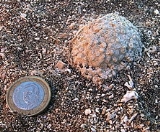
Rhodolith
Encyclopedia
Rhodoliths are colorful, unattached, branching, crustose benthic marine
red algae
that resemble coral
.
(Images: http://www.sitnews.us/0904news/091704/091704_rhodolith01.jpg http://www.mbari.org/seminars/2004/summer2004/july141.jpg) Rhodolith beds create biogenic habitat for diverse benthic communities. Common rhodolith species include Lithophyllum
margaritae, Lithothamnion
muellerii, and Neogoniolithon trichotomum.
The rhodolithic growth habit has been attained by a number of unrelated coralline red algae, organisms that deposit calcium carbonate
within their cell walls to form hard structures that closely resemble beds of coral. Unlike coral, rhodoliths do not attach themselves to the rocky seabed. Rather, they drift like tumbleweeds along the seafloor until they grow heavy enough to settle and form brightly colored beds (Image: http://www.sitnews.us/0904news/091704/091704_rhodolith02.jpg). While corals are animals that filter plankton and other organisms from the water for food, rhodoliths produce energy through photosynthesis. Scientists believe rhodoliths have been present in the world's oceans since at least the Eocene epoch, some 55 million years ago.
near Greenland
and in waters off British Columbia
, Canada. Globally, rhodoliths fill an important niche in the marine ecosystem, serving as a transition habitat between rocky areas and barren, sandy areas. Rhodoliths provide a stable and three-dimensional habitat onto which a wide variety of species can attach, including other algae, commercial species such as clam
s and scallop
s, and true corals. Living rhodolith beds are widely distributed throughout the Gulf of California, Mexico. Rhodoliths are resilient to a variety of environmental disturbances, but can be severely impacted by harvesting of commercial species.
In shallow water and high-energy environments, rhodoliths are typically mounded, thick or unbranched; branching is also rarer in deeper water, and most profuse in tropical, mid-depth waters.
Marine (ocean)
Marine is an umbrella term. As an adjective it is usually applicable to things relating to the sea or ocean, such as marine biology, marine ecology and marine geology...
red algae
Red algae
The red algae are one of the oldest groups of eukaryotic algae, and also one of the largest, with about 5,000–6,000 species of mostly multicellular, marine algae, including many notable seaweeds...
that resemble coral
Coral
Corals are marine animals in class Anthozoa of phylum Cnidaria typically living in compact colonies of many identical individual "polyps". The group includes the important reef builders that inhabit tropical oceans and secrete calcium carbonate to form a hard skeleton.A coral "head" is a colony of...
.
(Images: http://www.sitnews.us/0904news/091704/091704_rhodolith01.jpg http://www.mbari.org/seminars/2004/summer2004/july141.jpg) Rhodolith beds create biogenic habitat for diverse benthic communities. Common rhodolith species include Lithophyllum
Lithophyllum
Lithophyllum is a genus of thalloid alga comprising 120 species. The monomerous, crustose thalli are composed of a single system of filaments which grow close to the underlying surface. Lithophyllum reproduces by means of conceptacles...
margaritae, Lithothamnion
Lithothamnion
Lithothamnion is a genus of thalloid red alga comprising 103 species. Its members are known by a number of common names.Recorded common names are griuán, maërl, punalevä-suku, stenhinna and maerl. The monomerous, crustose thalli are composed of a single system of filaments which grow close to the...
muellerii, and Neogoniolithon trichotomum.
The rhodolithic growth habit has been attained by a number of unrelated coralline red algae, organisms that deposit calcium carbonate
Calcium carbonate
Calcium carbonate is a chemical compound with the formula CaCO3. It is a common substance found in rocks in all parts of the world, and is the main component of shells of marine organisms, snails, coal balls, pearls, and eggshells. Calcium carbonate is the active ingredient in agricultural lime,...
within their cell walls to form hard structures that closely resemble beds of coral. Unlike coral, rhodoliths do not attach themselves to the rocky seabed. Rather, they drift like tumbleweeds along the seafloor until they grow heavy enough to settle and form brightly colored beds (Image: http://www.sitnews.us/0904news/091704/091704_rhodolith02.jpg). While corals are animals that filter plankton and other organisms from the water for food, rhodoliths produce energy through photosynthesis. Scientists believe rhodoliths have been present in the world's oceans since at least the Eocene epoch, some 55 million years ago.
Habitat
Rhodolith beds have been found throughout the world's oceans, including in the ArcticArctic
The Arctic is a region located at the northern-most part of the Earth. The Arctic consists of the Arctic Ocean and parts of Canada, Russia, Greenland, the United States, Norway, Sweden, Finland, and Iceland. The Arctic region consists of a vast, ice-covered ocean, surrounded by treeless permafrost...
near Greenland
Greenland
Greenland is an autonomous country within the Kingdom of Denmark, located between the Arctic and Atlantic Oceans, east of the Canadian Arctic Archipelago. Though physiographically a part of the continent of North America, Greenland has been politically and culturally associated with Europe for...
and in waters off British Columbia
British Columbia
British Columbia is the westernmost of Canada's provinces and is known for its natural beauty, as reflected in its Latin motto, Splendor sine occasu . Its name was chosen by Queen Victoria in 1858...
, Canada. Globally, rhodoliths fill an important niche in the marine ecosystem, serving as a transition habitat between rocky areas and barren, sandy areas. Rhodoliths provide a stable and three-dimensional habitat onto which a wide variety of species can attach, including other algae, commercial species such as clam
Clam
The word "clam" can be applied to freshwater mussels, and other freshwater bivalves, as well as marine bivalves.In the United States, "clam" can be used in several different ways: one, as a general term covering all bivalve molluscs...
s and scallop
Scallop
A scallop is a marine bivalve mollusk of the family Pectinidae. Scallops are a cosmopolitan family, found in all of the world's oceans. Many scallops are highly prized as a food source...
s, and true corals. Living rhodolith beds are widely distributed throughout the Gulf of California, Mexico. Rhodoliths are resilient to a variety of environmental disturbances, but can be severely impacted by harvesting of commercial species.
In shallow water and high-energy environments, rhodoliths are typically mounded, thick or unbranched; branching is also rarer in deeper water, and most profuse in tropical, mid-depth waters.

